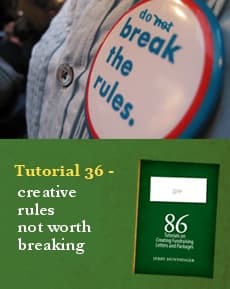Tutorial 36: creative rules not worth breaking.
Even a weak writer can be successful if he or she just follows the laws that others have broken with painful results.
- Written by
- Jerry Huntsinger
- Added
- January 24, 2019
TEST

At the heart of all this is the stark reality that some things work and some things don’t work. Some things work better than other things. Some things work really, really well. Some things simply fail.
You see, direct response marketing, as a measurable discipline, allows you to discover what’s good and what’s bad and what’s indifferent. You’ve got to be really stupid to test the same mistake over and over again.
Thus, for some advertising writers, direct response rules – and more specifically fundraising rules – are a curse on the creative juices.
For me, rules are tools.
Direct response rules rarely help us to be creative. Instead, they help us avoid agony. And this leads me to say what you hate anyone to tell you: ‘You’ve got to know the rules before you can break them.’
Thank goodness there are dozens and dozens of excellent books full of rules. You can read and read and read. There are newsletters and publications; and workshops; and seminars and speeches and conventions. So much information.
But ironically, many creative people refuse to read and absorb these rules.
Yes, I’m aware that the very notion of a ‘creative rule’ seems like an oxymoron, such as ‘military intelligence’ or ‘the punk aesthetic’.
I believe it is possible to develop user-friendly rules that are creative springboards. Let me see if I can explain to you what I mean.
Creative rule 1: never end a letter until you have said all you have to say.
Relate that rule to long copy and the fact that long copy usually out pulls short copy. After you have written all you have to say, go back and edit your long copy. Organise it. Move stuff around. Chop. Underline. Put in headers. Make it easy on the eyes.
Creative rule 2: write a letter that your mother or grandmother will really enjoy reading.
Maybe you hate the reality that most cheques are signed by women. Relax. Go with the flow. Visualise your donor as your mother or grandmother. Make her proud of you.
Creative rule 3: arrange your words on a piece of paper so that the reader immediately feels a sense of excitement just by glancing at the paper.
This quickly eliminates long lines, huge paragraph, no indentation and a blocky style. It calls for one-liners, handwritten notes in the margins. Subheads. Numbers. Things that pop out of the page.
Creative rule 4: if your wife or husband says, ‘I would never read anything like that’ you’ve probably written a good letter.
Of course, you won’t go far in the business, though, if you are desperate for creative approval from your family or peers. The mistake your spouse makes is assuming that other women who receive your letter will approach the experience intellectually. Wrong!
Creative rule 5: you really don’t have a reader’s attention unless that individual is busy doing something with his or her hands.
Beginners hate premiums. Direct mail survivors adore premiums. If people are hanging on to your premium, you have their attention. Makes sense, doesn’t it? And if they can’t throw away that premium, you force them to deal with the letter.
Creative rule 6: since it is physically impossible to read a letter until the envelope has been opened, make it impossible for the reader not to rip open the envelope and, hopefully, with some degree of anticipation about the inside contents.
Be grateful that human beings are so curious. And when they read their mail they are constantly searching for something exciting. Or, at the very least, something to break up the boring events of a typical day. Or something to bring them down after a stressful day. So why try to save money on a cheap outer envelope?
Creative rule 7: write with passion. Edit with objectivity.
Fight the curse of falling in love with your own words. Don’t edit right after you finish writing a draft. Cool off. Come back to it and pretend you never saw it before. Chop. Whittle. Zap. Make sure it flows and has focus for someone who has absolutely no background on the subject.
Pretend you are editing a junior writer, not yourself. Be ruthless. Disdainful. Move words and sections around. Search for trigger words that will make a stronger headline or lead paragraph.
Creative rule 8: write a letter that Reader’s Digest would publish.
Okay, I’ll explain what I mean: many organisations have developed their own highly technical vocabulary. Experiment with substituting common, easy-to-understand words for any technical, esoteric words. Write about real, live people.
Creative rule 9: if you can only afford to test one thing, forget the copy and the offer. Test the list.
You work hard to come up with good copy. And a good offer. But unless you have a high level of confidence in the lists you are using, you’ll never discover whether the copy, offer, or list is helping or hurting the package. (Rule 3465: never test more than one element at a time. Or is that rule 3466?)
Creative rule 10: the reader doesn’t care anything about your organisation.
He or she only cares about what you are doing, not why you are doing it. Many nonprofit executives spend their careers caught in the agony of self-definition. What a pity. They are concerned that donors give money for logical, rational reasons.
Creative rule 11: never introduce a new idea in the PS.
Creative rule 12: clever graphics rarely increase response.
Creative rule 13: if you have a celebrity involved in the package, the celebrity should write the lift letter, not the main letter.
Creative rule 14: a package cannot accomplish two goals at the same time; that is, ask for a current gift and a will, or ask for a gift and sign up a volunteer, etc, etc, etc.
Creative rule 15: every page of the letter must have its own ‘interest-grabbing’ graphics.
That is, indented paragraphs, underlining, numbers to follow, marginal notes, or something that pops out at the reader.
And if you are editing your own copy or someone else’s copy, never, never add additional material by lengthening paragraphs. Instead, add new paragraphs, or chop old copy, or add additional pages.
Creative rule 16: each paragraph must begin with either a connective or an action word.
You don’t judge a letter on its literary strength – only on its motivational quality. An action word opens the paragraph with excitement.
Creative rule 17: metered/franked first class is a terrible waste of postage money.
Either use a real stamp or use teaser copy that says ‘first class mail’ in bold type. Metered first class looks remarkably like metered third class.
Creative rule 18: letters are scanned before they are read.
Implications? Short paragraphs increase readership. A PS increases readership. A headline increases readership. One-sentence paragraphs increase readership. One-word paragraphs(!) increase readership.
Creative rule 19: simple words for simple folk.
The average person, regardless of education, reads at about the level of a 13 or 14 year old. Most individuals who read your fundraising letters will absolutely not struggle to understand technical terms, your slick abbreviations, your convoluted case statements, or your organisational double talk.
Creative rule 20: a letter must have a human interest story.
Creative rule 21: always give the reader crystal-clear instructions.
Explain exactly how to use the response device, mention the reply envelope, tell the donor what boxes to check. It’s better to run the risk of being obvious than fail to plant response suggestions in the donor’s mind.
Creative rule 22: and, finally, the most important rule of all: don’t trust rules one to 21.
On that beautiful sunny day when you are full of inspiration and even your clogged arteries are full of vigour – dump the rules. Walk to the edge of the cliff and jump off with a new idea. You may crash.
But you may soar. Chance it.
© SOFII Foundation 2010-2014.



 Gwen Chapman is a passionate advocate for donor-centric fundraising. She is a senior consultant with international experience in the non-profit sector in Canada, the United States, the UK and South Africa. She explains the importance to these tutorials
Gwen Chapman is a passionate advocate for donor-centric fundraising. She is a senior consultant with international experience in the non-profit sector in Canada, the United States, the UK and South Africa. She explains the importance to these tutorials 


















